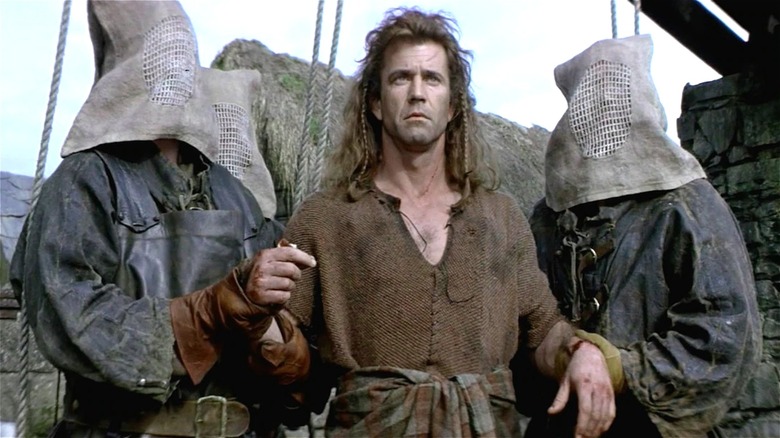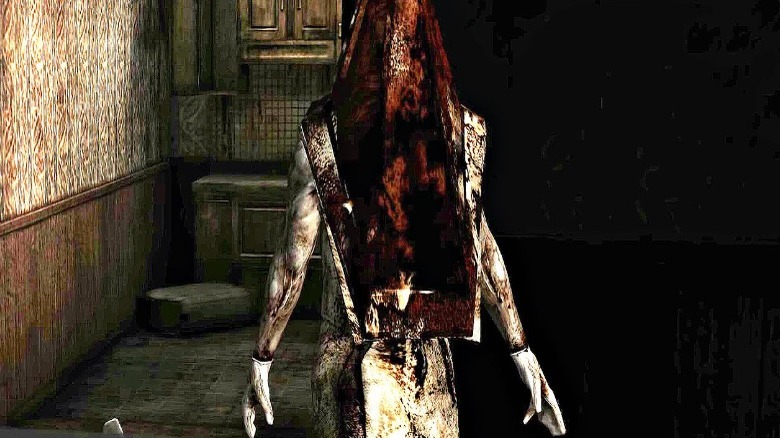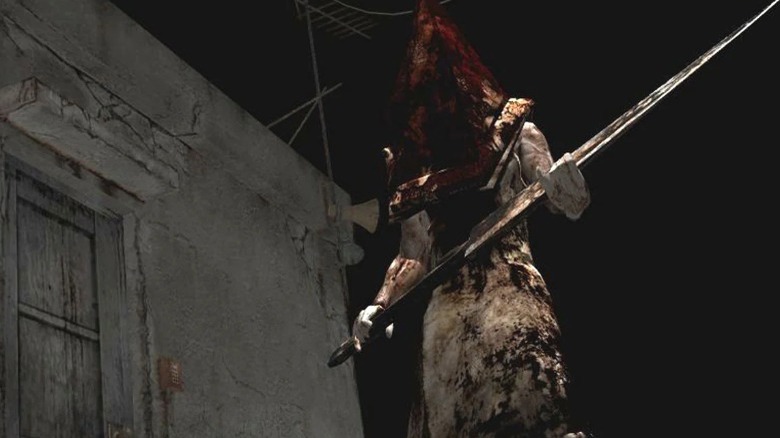A Scene From Braveheart Inspired The Creation Of Silent Hill's Most Notable Monster, Pyramid Head
When "Silent Hill 2" was released in 2001, the game changed the landscape of the survival horror genre in unprecedented ways. The second installment in the "Silent Hill" video game series accentuated the nightmarish terror of the original, transporting players into a liminal space where the most grotesque fears came alive. Among the many monsters that lurk around the shapeshifting town of Silent Hill is Pyramid Head, a faceless, hulking humanoid who still scares the bejesus out of players when revealed. Over the years, Pyramid Head achieved iconic status as a video game antagonist and began to represent the franchise as a whole. Although Pyramid Head was exclusively designed by Masahiro Ito to represent James Sunderland's repressed guilt in the second game, the growing popularity of the monster gradually distanced it from its original purpose.
Ito, who had served as art director and monster designer for "Silent Hill 2," was personally involved in the creation of the base storyline of the game, alongside scenario writer Hiroyuki Owaku, game director Masashi Tsuboyama, drama director Suguru Murakoshi, and character designer Takayoshi Sato. Ito and co. came up with the core concept for Pyramid Head when they realized that they needed a formidable chaser monster for the plot to unravel, as every entity in "Silent Hill" is an extension/manifestation of a character's subconscious. Pyramid Head is supposed to be James Sunderland's monster, a reflection of his all-consuming guilt and need for retribution. Apart from this, a ton of other aspects factored into Pyramid Head's background and role within the in-game narrative, such as the historical context of his executioner origins and the supernatural nature of his powers.
So, where did Ito find inspiration for the backstory of his faceless monster?
A distorted memory of executioners
In a tweet explaining the inspirations behind Pyramid Head, Ito credited a scene from "Braveheart." The scene in question is when William Wallace (Mel Gibson) is about to be beheaded and two hooded executioners can be seen standing next to him. Ito clarified that while the design of Pyramid Head, including the rusted metal helmet, was directly inspired by his "Strange Head" drawings years ago, the idea that Sunderland's monster would be an executioner was inspired by the aforementioned scene from "Braveheart."
For reference, here's what Ito's "Strange Head" series looks like:
The design of Pyramid Head is based on the 1st one_Some of oil/acrylic paints in my art student days (1993 – 1996). "Strange head" series. pic.twitter.com/J1RWAS9vlS
— 伊藤暢達/Masahiro Ito (@adsk4) July 26, 2017
Taking the executioner scene in "Braveheart" as a key reference point, Ito dove deeper into the history of these hooded figures and incorporated that into the lore of the primary monster in the game. As Pyramid Head symbolizes Sunderland's arc as a protagonist, the monster design was carefully planned out to reflect various aspects of his personality.
Although there is no dearth of creepy, faceless monsters in survival horror games, there is something viscerally frightening about Pyramid Head, whose presence is meant to unsettle players amid an already high-stakes scenario. The character exists solely to remind Sunderland of his past and navigate the repressed emotions that have been festering over time. After Konami turned Pyramid Head into a flagship figurehead of the franchise, Ito's original concept lost its meaning, as it was morphed into a generic monster figure who was featured in subsequent games and spin-offs, including "Silent Hill Homecoming" and "Silent Hill: Book of Memories." No wonder Ito was pissed off by this turn of events.
While Pyramid Head's mainstream appeal might have morphed an artist's creation into something he had never intended, Ito's iteration in "Silent Hill 2" still remains unparalleled. Here's why.
Pyramid Head shaped the terrifying journey of Silent Hill 2
In "Silent Hill 2," Sunderland arrives at the titular town after receiving a letter from his deceased wife Mary, who had been suffering from a terminal illness. Over the course of the increasingly disorienting gameplay and narrative reveals, the player realizes that the monsters in the town mirror his repressed sexual frustration during his wife's illness and the resulting guilt from these sentiments. Subconsciously craving punishment for his actions, Sunderland comes face to face with Pyramid Head, who hounds him throughout the game, and depending on the player's choices, Sunderland can resolve his inner turmoil in various ways.
The monster's direct connection to "Braveheart" ties in neatly with the lore of the town being inhabited by executioners and their descendants, which adds an edge of brutality to the history of Silent Hill. Ito also created an elaborate backstory that connects Pyramid Head to Valtiel, an angelic/demonic being depending on the iteration of "Silent Hill" one chooses to play. Whenever Pyramid Head interrupts Sunderland's journey to help other characters or uncover the truth about his past, the uneasy connection between the two becomes more poignant, lending to the eerie nature of the protagonist's arc. Most of the time, the monster dude does not even attack you: he just stands menacingly, breathing loudly in a corner, watching you. Interestingly, the anxiety heightens when he is not there, as if harkening a prelude for something altogether terrifying.
Even 22 years later, the game's antagonist still manages to frighten, as the psychological implications of Pyramid Head run deeper than its terrifying visage. The credit goes to Ito, who lovingly crafted a monster meant to terrify us into confronting our demons, no matter the cost.


